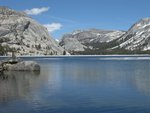Bears have started to emerge from their dens in Yellowstone National Park. Grizzly bear tracks were spotted in the Blacktail Deer Plateau area east of Mammoth Hot Springs on Friday, February 19.
Soon after emerging from their dens, bears begin looking for food. Bears are attracted to elk and bison that have died over the winter. Elk and bison are such a prized source of food that bears will aggressively defend these carcasses. Anyone disturbing a bear feeding on a carcass puts themselves at serious risk for injury.
Park regulations require you to stay 100 yards from black and grizzly bears at all times. The best defense is to stay a safe distance from bears and use your binoculars, telescope, or telephoto lens to get a closer look. Hikers, snowshoers, and cross-country skiers are encouraged to travel in groups of three or more, make noise on the trail, and keep an eye out for bears. Bear pepper spray has proven to be a good last line of defense if you keep it handy and use it according to directions when the bear is within 30 to 40 feet. While firearms are allowed in the park, discharge of a firearm is a violation of park regulations. Even the park’s law enforcement rangers who carry firearms on duty rely on pepper spray, and not their weapons, as the most effective means to deal with a bear encounter.
Seasonal Bear Management Area closures are designed to reduce encounters with bears in areas that have a high density of elk and bison carcasses and provide areas where bears can roam free from human disturbance. They include Firehole Lake Drive, which will be closed from Wednesday, March 10 through June 15; and the Blacktail area south of the road between Mammoth Hot Springs and Tower Junction, which will be closed from March 10 through June 30.
Prior to hiking, skiing, or snowshoeing in the park, check at park visitor centers or the park web site at http://www.nps.gov/yell/parkmgmt/bearclosures.htm for dates and locations of bear closure areas.
Visitors are also reminded to keep food, garbage, barbecue grills and other attractants stored in hard-sided vehicles or bear-proof food storage boxes. This helps keep bears from becoming conditioned to human foods, and helps keep park visitors and their property safe.
Bear sightings should be reported to the nearest visitor center or ranger station as soon as possible.
Edited 1 time(s). Last edit at 02/26/2010 10:55AM by eeek.
Home
>
General Discussion
>
Topic
Re: Yellowstone Bears Are Waking Up
All posts are those of the individual authors and the owner
of this site does not endorse them. Content should be considered opinion
and not fact until verified independently.
February 26, 2010 10:55AM | Admin Registered: 16 years ago Posts: 17,140 |
|
Re: Yellowstone Bears Are Waking Up February 27, 2010 01:30AM | Registered: 16 years ago Posts: 141 |
February 27, 2010 01:32AM | Admin Registered: 16 years ago Posts: 17,140 |
February 27, 2010 04:58AM | Moderator Registered: 16 years ago Posts: 1,942 |
February 27, 2010 01:36PM | Admin Registered: 16 years ago Posts: 17,140 |
February 27, 2010 08:02PM | Moderator Registered: 16 years ago Posts: 1,942 |
Not real new (Aug 2006), but interesting discussion of Black Bear attacks and defense on Washington State University site:
http://ext.nrs.wsu.edu/publications/Blackbears1.htm
and links to other sites at http://wdfw.wa.gov/wlm/living/bears.htm
The cure for a fallacious argument is a better argument, not the suppression of ideas.
-- Carl Sagan
Edited 1 time(s). Last edit at 02/27/2010 08:13PM by Frank Furter.
http://ext.nrs.wsu.edu/publications/Blackbears1.htm
and links to other sites at http://wdfw.wa.gov/wlm/living/bears.htm
The cure for a fallacious argument is a better argument, not the suppression of ideas.
-- Carl Sagan
Edited 1 time(s). Last edit at 02/27/2010 08:13PM by Frank Furter.
Sorry, only registered users may post in this forum.


